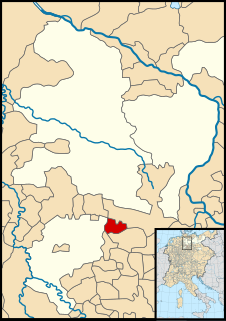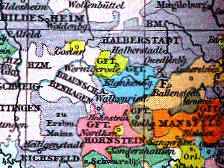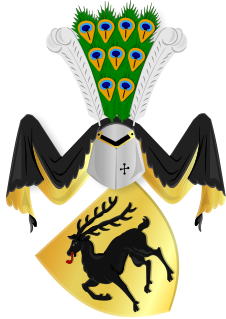
The Harzgau was a medieval shire ( Gau ) in the northeastern foorhils of the Harz mountains, part of the Eastphalia region of Saxony.
Gau is a Germanic term for a region within a country, often a former or actual province. It was used in medieval times, when it can be seen as roughly corresponding to an English shire. The administrative use of the term was revived as a subdivision during the period of Nazi Germany in 1933–1945. It still appears today in regional names, such as the Rheingau or Allgäu.

The Harz is a Mittelgebirge that has the highest elevations in Northern Germany and its rugged terrain extends across parts of Lower Saxony, Saxony-Anhalt, and Thuringia. The name Harz derives from the Middle High German word Hardt or Hart, Latinized as Hercynia. The Brocken is the highest summit in the Harz with an elevation of 1,141.1 metres (3,744 ft) above sea level. The Wurmberg is the highest peak located entirely within the state of Lower Saxony.

Eastphalia is a historical region in northern Germany, encompassing the eastern Gaue (shires) of the historic stem duchy of Saxony, roughly confined by the River Leine in the west and the Elbe and Saale in the east. The territory corresponds with the southeastern part of the present-day states of Lower Saxony, western Saxony-Anhalt and northern Thuringia. Together with Westphalia, central Angria and Nordalbingia it was one of the four main Saxon administrative regions. It should not be confused with East Westphalia (Ostwestfalen).
It included the towns of Halberstadt, Quedlinburg, and Osterwieck, and was bounded by the Oker in the west, by the Großes Bruch swamps in the north, the Bode in the east, and the Harz range in the south. The county was bordered (clockwise) by the Salzgau, the Derlingau, the Nordthüringgau, the Schwabengau, the Thuringian Helmegau, and the Liesgau.

Halberstadt is a town in the German state of Saxony-Anhalt, the capital of Harz district. Located north of the Harz mountain range, it is known for its old town centre that was severely damaged in World War II and rebuilt in the following decades.

Quedlinburg is a town situated just north of the Harz mountains, in the district of Harz in the west of Saxony-Anhalt, Germany. In 1994, the castle, church and old town were added to the UNESCO World Heritage List.

Osterwieck is a historic town in the Harz district, in the German state of Saxony-Anhalt.
Counts in the Harzgau were:
- Frederick I 875/880
- Frederick II 937 and 945, son of Frederick I.
- Volkmar I (d before 961), probably son of Frederick II.
- Frederick III, son of Volkmar
- Thietmar, Count in the Harzgau and Nordthüringgau, d 3 October 959
- Frederick (d July 1002/15 March 1003), 995 to 996 count palatine in Saxony, Count in the Harzgau and Nordthüringgau
- Liutger, 1013 Count, 1021 Count in the Harzgau, 1013 to 1031 (recorded) (Supplinburger family)
- Bernard (d before 1069), 1052 Count in the Harzgau and Derlingau as well as North Thuringia, 1043 to 1062 (recorded), probably nephew of Liutger
- Gebhard of Supplinburg (d 9 June 1075 in the Battle of Homburg an der Unstrut), 1052 Count in the Harzgau, son of Bernard, father of Lothair III, Holy Roman Emperor
Count palatine is a high noble title, used to render several comital styles, in some cases also shortened to Palatine, which can have other meanings as well.

The Derlingau was an early medieval county (Gau) of the Duchy of Saxony.

Thuringia, officially the Free State of Thuringia, is a state of Germany.
In the course of the Middle Ages the counts of Wernigerode established themselves in this region. [1]

In the history of Europe, the Middle Ages lasted from the 5th to the 15th century. It began with the fall of the Western Roman Empire and merged into the Renaissance and the Age of Discovery. The Middle Ages is the middle period of the three traditional divisions of Western history: classical antiquity, the medieval period, and the modern period. The medieval period is itself subdivided into the Early, High, and Late Middle Ages.

The County of Wernigerode was a state of the Holy Roman Empire which arose in the Harzgau region of the former Duchy of Saxony, at the northern foot of the Harz mountain range. The comital residence was at Wernigerode, now part of Saxony-Anhalt, Germany. The county was ruled by a branch of the House of Stolberg from 1429 until its mediatization to the Kingdom of Prussia in 1806. Nevertheless, the county remained in existence - with one short interruption - until the dissolution of the Kingdom of Prussia in 1918.
By the 14th century, after the disintegration of the Duchy of Saxony, the Harzgau had been replaced by four smaller states:

The County of Blankenburg was a state of the Holy Roman Empire. Its capital was Blankenburg, it was located in and near the Harz mountains.







